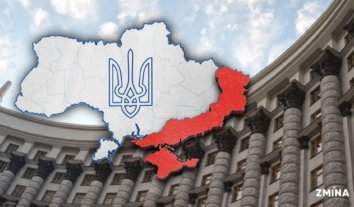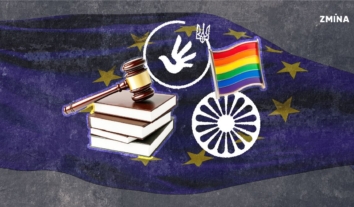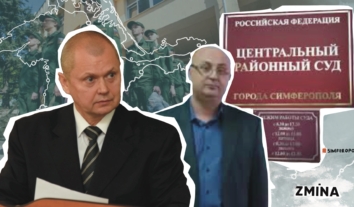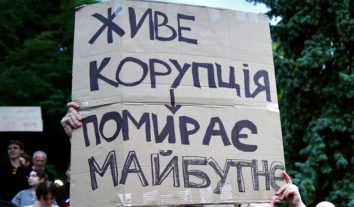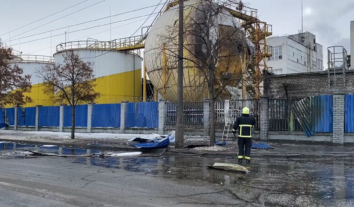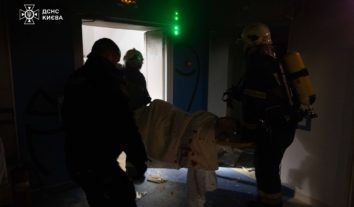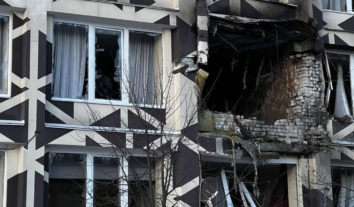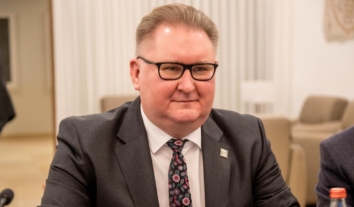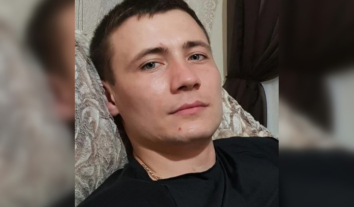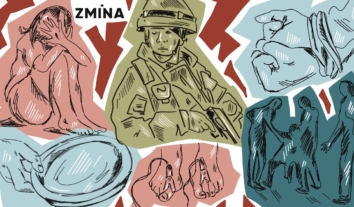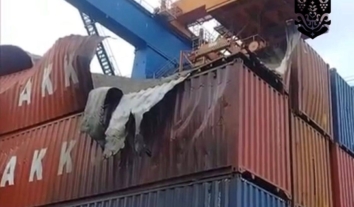‘Do you need a corpse?’: reportage from Izyum hospital where hundreds of civilians, including those tortured almost to death by Russians, were saved during occupation
From the beginning of the full-scale invasion and until the liberation of Izyum from the Russian occupiers, the Izyum Central Hospital did not stop working even for a day. During the month of the heaviest shelling and bombing, seven people, including a plumber, an electrician, nurses, a traumatologist and a surgeon, provided care to hundreds of injured and sick.
ZMINA tells how surgeries were performed and babies were born in the basement of the dilapidated hospital, as well as how two civilians tortured almost to death by the Russians were saved here.
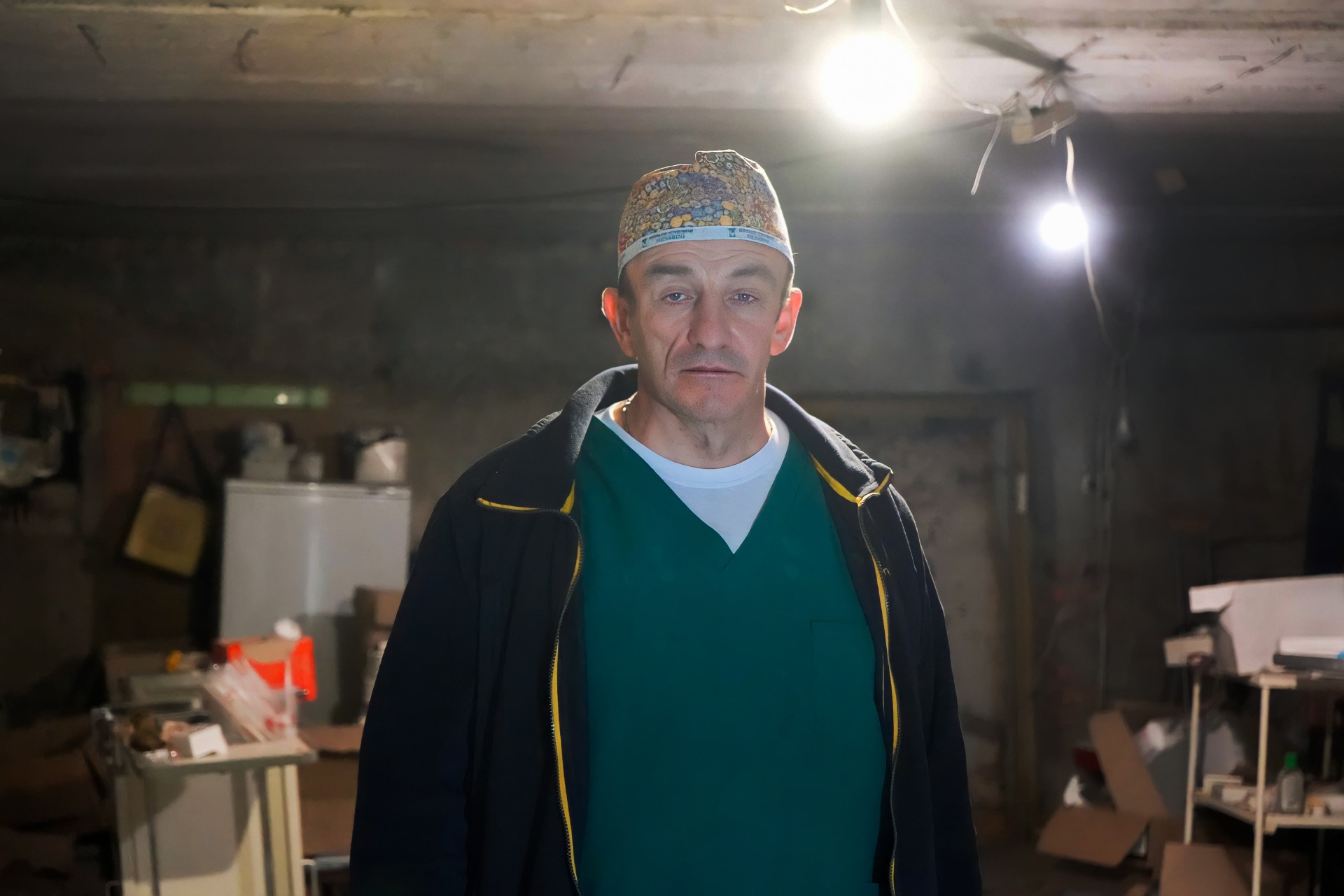 Yuri Kuznetsov, traumatologist / Photo: Yelyzaveta Sokurenko
Yuri Kuznetsov, traumatologist / Photo: Yelyzaveta Sokurenko‘Hospital is open’
Frozen and rain-soaked dogs huddle under the roof of the ambulance access to the emergency department of the Izyum Central Hospital. Sometimes they are petted by people who go out on the porch. A white sheet on the front metal-plastic door informs: “Hospital is open”.
This is currently the only entrance to the premises. The admission department, and also the second floor where the urgent care and two operating rooms were located, had been completely destroyed by Russian shells at the beginning of March. The territory to the left of the hospital is mined, which is indicated by a corresponding red sign.
“If you had seen our hospital at the beginning of March: there were no windows, everything had collapsed,” says traumatologist Yuri Kuznetsov.
He did not leave the hospital for almost 4.5 months since the beginning of the full-scale war. Now, he says, it has become a little easier, but “it’s still difficult.” Doctors and healthcare personnel return to the town, and the traumatologist works in shifts with his colleagues. In particular, he works side by side with chief of surgery Anatoliy Kovalenko.
Kovalenko and Kuznetsov have just left an operating room. Two people with mine blast injuries were brought to the hospital. When the Russian military retreated from Izyum, they littered the town with “petals” і .
“On September 20, the patient stepped on a landmine but sought medical advice only three days later. He already had purulent infection. Another half day and he would have died. Now he has a good chance for life,” says the traumatologist. This is already the tenth such patient since the liberation.
Kuznetsov tells us that the hospital has provided care to almost 400 people with mine blast injuries – from minor injuries to traumatic amputations – during the entire period of hostilities. People with pneumonia and bronchitis also went to the hospital when the shelling stopped for a while and the townspeople dared to come out of their shelters.
Currently, the hospital corridor is crowded and noisy. Elderly people are waiting for an appointment near the offices, medical staff and patients, journalists and military personnel are walking back and forth. Kilograms of potatoes and humanitarian aid are carried on medical stretchers. A colleague stops Kuznetsov to tell him about how much fuel was brought and to discuss the characteristics of a new generator as two generator “burned down” at the hospital during the months of occupation. One of the patients came to the traumatologist to get the promised medicine.
Kuznetsov was actually the chief doctor in the hospital during the occupation. People’s deep respect for him is still felt.
“Let’s go, I’ll show you our famous basement,” the doctor says, already going down the stairs.
On March 1, when massive shelling of the town began, the staff asked relatives of the patients to take them out of the hospital, some relatives took them themselves. Five days later, Izyum began to be bombed from the air, then doctors and patients from four floors moved to the basement. In total, 72 people were accommodated there.
Beds with mattresses piled on them still stand along the long corridor with concrete walls. Communication pipes lie overhead.
‘It was easier with medicines than food’
“From March 7 to 12, patients and the State Emergency Service staff were evacuated to Slovyansk. At that time, there were two doctors in the hospital: me and another surgeon,” the traumatologist recalls.
Already a week after the evacuation, as soon as it became a little safer to move around the town, Kuznetsov remained the only doctor. However, he had a team all the time: an electrician, a plumber, nurses, an ambulance driver, and midwives. Seven people.
“Patients were admitted day and night. The whole team worked. It’s thanks to them… Well, anyway, we survived. Some people had fatal injuries – wounds to head, heart. And we managed to help them. There were not many of them, but there were. My acquaintances were among them,” the doctor recalls.
At the end of April, some of Kuznetsov’s colleagues returned to the hospital. At the same time, after the shelling of Izyum on May 9, one of the doctors, who also operated, left the town. A nurse also “couldn’t stand it”. That day, more than 10 injured, including seriously injured, were brought to the hospital at the same time.
However, the staff is not offended by the colleagues who left, Kuznetsov says:
It was difficult to see human suffering. We all had depression, we calmed each other down with different words and actions. But with each saved life, we understood that our work was not in vain.
Operations were also performed in the basement – in a separate large room locked with a key. Patients were operated on the table, stabilized, and transferred to a corridor.
“Conditions are unsanitary, of course,” Kuznetsov comments, looking around the room.
He remembers the “best thing” that happened to him during that period: he and midwives helped four women to give birth. There were no complications, healthy children were born. He also talks about the “worst thing” – there was nobody to address and ask for help:
“We were on our own, we could not call someone or consult. We had only our knowledge. I had to remember what we were taught in different fields of medicine, we could rely only on ourselves.”
The operating room is lined with shelves with medicines. The traumatologist says that it was easier with medicines during the occupation than with food. Even now, the hospital is primarily in need of electric stoves for cooking as the ones used earlier broke down.
“We were a hub hospital, we treated COVID-19 patients. We had analgesics, antibiotics, hemostatic drugs, hormonal drugs, etc. left. This helped us a lot,” Kuznetsov explains and continues, “people helped us a lot. You know, to put it mildly… There was nothing to eat, people looted shops and pharmacies. What they didn’t need, they brought to us. Every day, bags were brought and left under the door. The owner of one of the private pharmacies at the hospital also came one day and said: ‘Take everything and hand it out to people’.”
Izyum ambulance transported the seriously injured to the then-occupied Kupyansk, as well as to Russia. The Russian military forbade sending patients to the unoccupied territory of Ukraine.
The occupiers came to the hospital in March: they wanted it to continue working. In April, they established a military hospital in one of its buildings – a few meters from the main building. Bloody military litters, scattered clothes, shoes, bandages, and drawings of Russian children “with words of gratitude to a soldier” are still there.
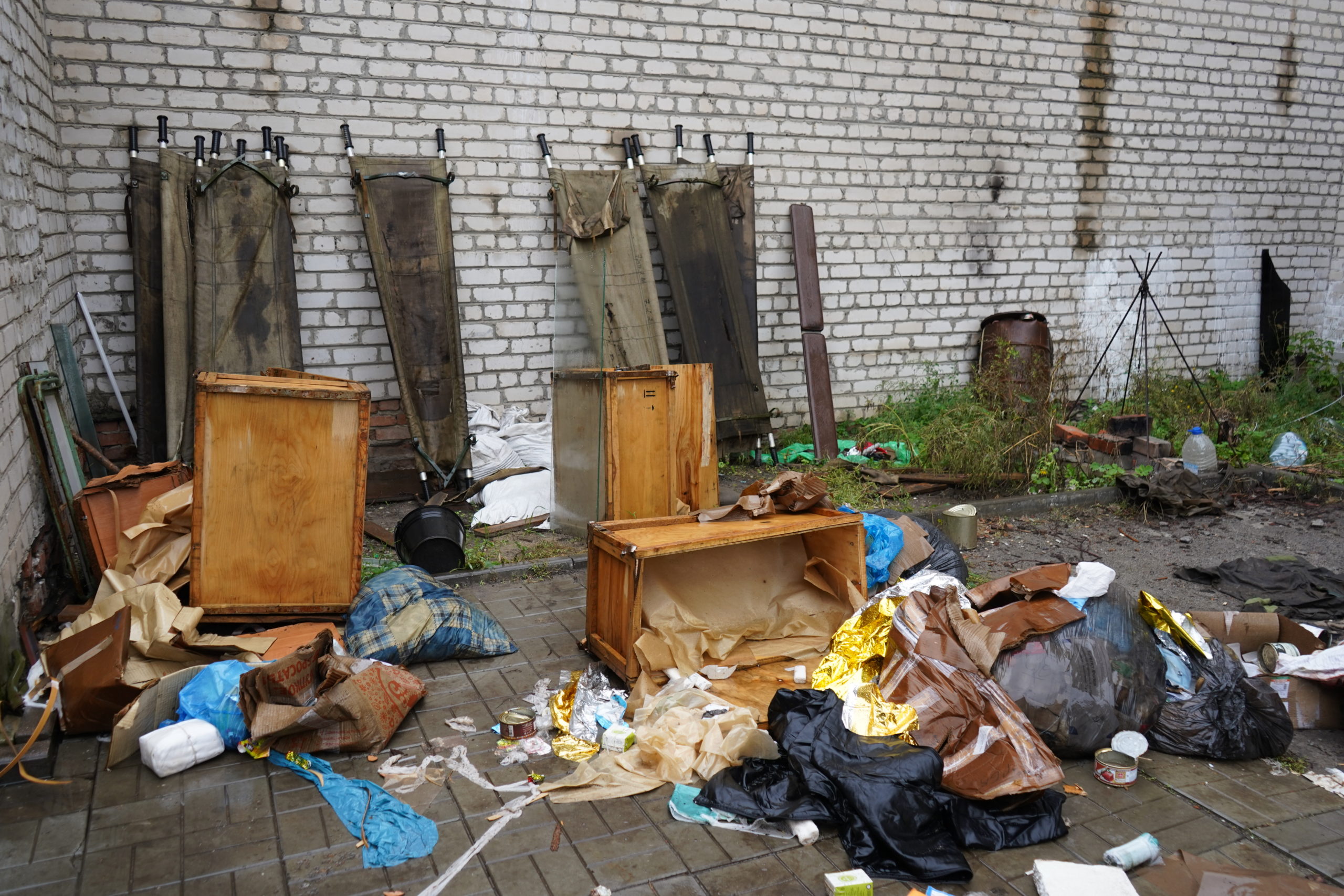 The Russians established a military hospital in one of the buildings in hospital’s territory / Photo: Yelyzaveta Sokurenko
The Russians established a military hospital in one of the buildings in hospital’s territory / Photo: Yelyzaveta SokurenkoThe Russians posted guards around the hospital, so it was impossible to freely move around the area, Kuznetsov says. However, the staff hardly went above the 1st floor for a long time. And when they went up, they discovered that some of the equipment not destroyed by the shelling had been stolen.
In April, the occupiers appointed ex-mayor of Izyum Oleksandr Bozhkov as the head of the hospital. However, the traumatologist is reluctant to talk about the collaborators, speaking only about what is directly related to health care:
“I was not interested in who were they, what they did. Then another head of the hospital was appointed. From September 1, there was a struggle for power. He came here and told us that we didn’t know how to work. But he had run away the day before the town was liberated… Now everyone is silent about everything, we try to communicate less with each other so as not to stumble upon [potential traitors]… Healthcare workers are unwilling to give interviews either because many of them have relatives in Russia.”
Kuznetsov, like many residents of Izyum, fears that the occupiers may return. He tells us how one of his colleague, a forensic medical expert, was killed by the Russian military. It happened in a morgue in the hospital’s territory:
“I was not there. People say that they were discussing politics, and he was shot at his workplace. It was a Chechen, my colleague did not want to give his car, word for word and…”
‘After torture, I had to learn how to walk again’
The hospital staff saw the consequences of other Russian war crimes. At least two men tortured by the occupiers were actually saved here.
Oleksandr Hlushko, 53, slowly moving his legs, goes down from his apartment and sits on a bench near the house. The Russian military detained the man twice. He says that he had to learn how to walk again after torture.
“God give health to our Kuznetsov, he brought me to my senses,” says Hlushko gratefully.
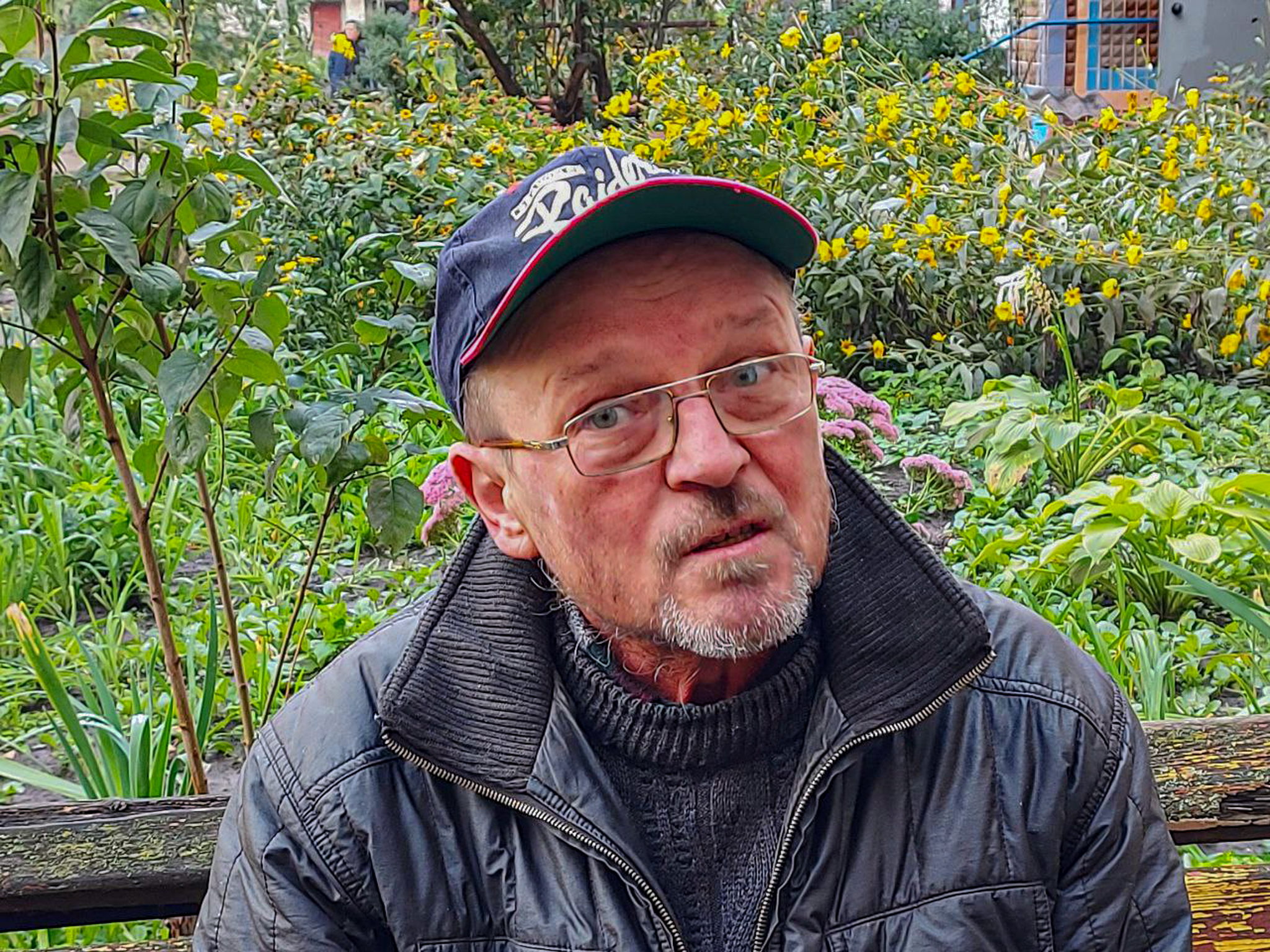 Oleksandr Hlushko / Photo: Serhii Kochmarskyi
Oleksandr Hlushko / Photo: Serhii KochmarskyiHe was detained unlawfully for the first time on May 5. Four military men wearing balaclavas came to the man’s house, put a bag over Hlushko’s head and took him to the basement. Other civilians were not held there as far as the man could tell.
The Izyum resident is convinced that he was told on. In 2018-2020, he participated in the anti-terrorist operation in eastern Ukraine:
“They intended to detain me. They entered the house, turned everything upside down. They said: ‘You took part in the anti-terrorist operation, so you are a member of the territorial defense, give us all the information about caches, weapons, fighters’.“
On the second day of detention, Hlushko tried to escape:
“I found a pebble, rubbed the rope with which I was tied. Then I shook the door: it was closed by the pipe, it fell out. I thought that someone would run there, but no one did.”
However, on his way home, the man came across a Russian checkpoint. He was returned to the basement and tortured every day: beaten on the heels, on the head with a helmet, two ribs were broken.
“One of their soldiers, while those who beat me were gone, came in and gave me water, lifted me from the floor onto a couch. I asked: ‘Where are you taking me’, then he answered: ‘Do you want to lie normally?’ Then a Chechen ran in and started to dance lezgin on me,” the man recalls.
So it was for five days, he says:
“They turned me into a vegetable. When nothing could be done with me, they dragged me across the highway and dumped me in the bushes near the Central Hospital. I purred: ‘Help.’ One woman saw me, came to me, then called our guys, and they took me home.”
Despite the neighbors’ attempts, they were unable to help Hlushko walk on his own. Then he was taken to the hospital by ambulance, the driver invented another name for him on the way:
“I learned how to walk for a month and a half. They hid me there until I could climb the stairs myself.”
They came for Hlushko for the second time at the end of August. A man and a neighbor were watching a movie:
“They ask: ‘Hlushko?’ I say: ‘Glushko.’ They respind: ‘Let’s go.’ They were wearing balaclavas, again put a bag on my head. I ask them: ‘Let me at least put my pants on.’ I was in underpants and a T-shirt. They didn’t let. A local boy who was on duty in a temporary detention facility, a collaborator, brought me clothes later, because it quickly got cold. He fed us a little.”
This time, the man was taken to the basement of the Izyum Police Department which the occupiers turned into a torture chamber. At first, two people were held in a cell, then three, then four. Some were held for a day, some were released and later taken back.
“They interrogated me on the first floor in a large room. For the second time, I was detained for the same reason as the first time. They beat me with their hands less but tortured me with electric current, putting two shockers in me,” recalls the resident of Izyum.
Here he stayed until the town was liberated:
“At night, before our troops entered, those goblins were running around and writing down how many people were in cells. I began to say goodbye to myself. I thought they would throw a grenade into a ‘feeder’. I heard them talking about 24 people, but their military also seemed to be among them. In the morning, I heard a fuss in the corridor, sat up, listened, and heard a voice in a neighboring cell: ‘Guys, don’t panic: let’s go out, go upstairs, look for our documents, go home and sit there because we can get caught in the crossfire’.”
According to Hlushko, a local civilian with a “familiar face” released people from the basement.
‘Do you need a corpse?’
The pages torn from a notebook are still stuck on the walls of cells of the temporary detention center in the basement of the police department. The number of those unlawfully detained is handwritten on them, probably by Russians: “1 person”, “3 people”, “4 people”. In total, according to these sheets, there were 15 people in six cells.
67-year-old Mykhailo Ivanovych Chendey was held in the same cell as Hlushko.
An elderly man lights a cigarette with his right hand, and carefully holds the bandaged left one on his lap. Two Russian soldiers wearing balaclavas took him from the yard of his house on August 29. The hospital staff say that the man was “unlucky to be in the wrong place at the wrong time.”
“They took me away because, they say, I am a ‘terrorist’, in short. A ‘spotter’,” Mykhailo Ivanovych says with a short laugh.
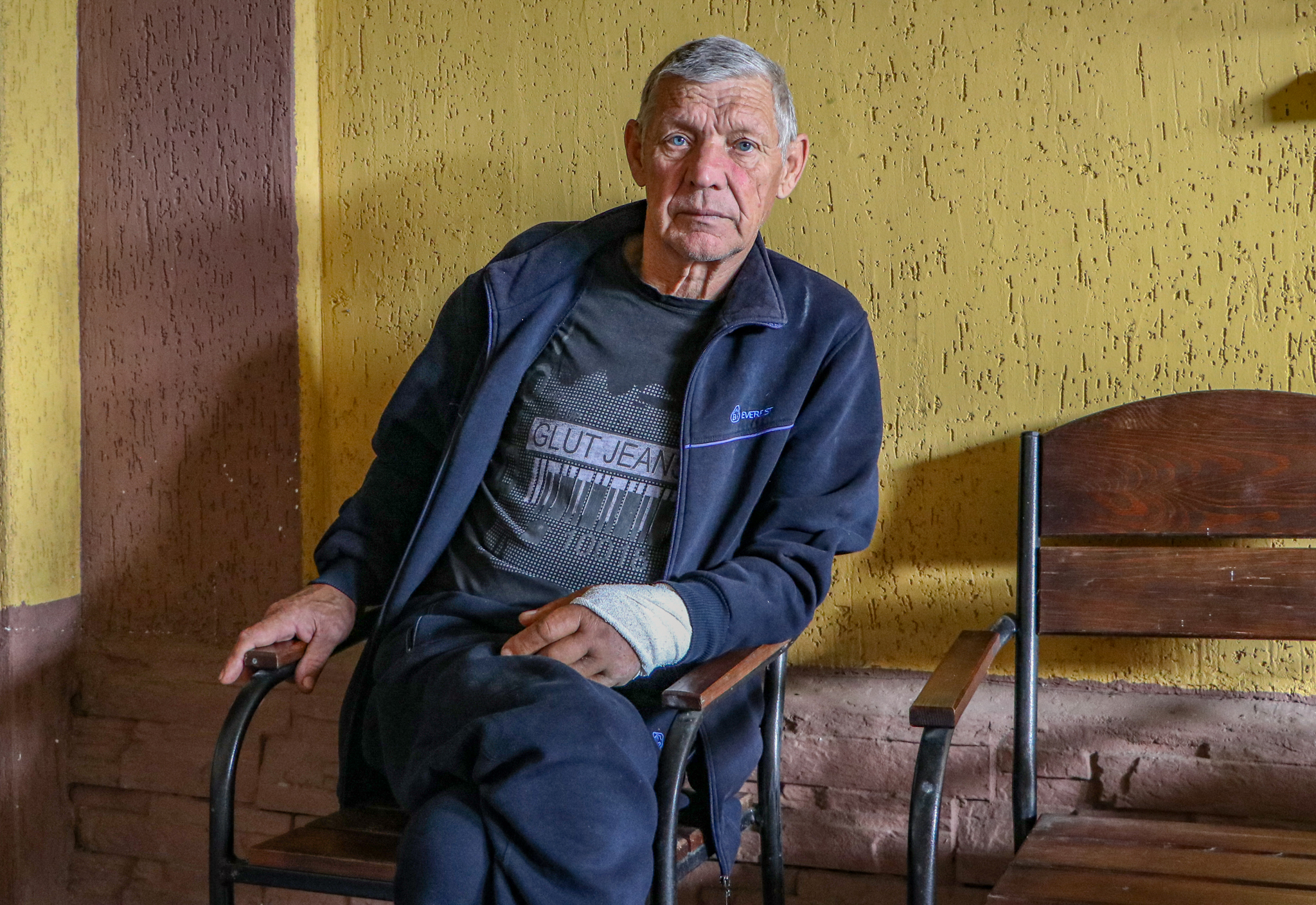 Mykhailo Chendey / Photo: Serhii Kochmarskyi
Mykhailo Chendey / Photo: Serhii KochmarskyiThe day before, the resident of Izyum returned to the occupied town from Poltava region, where he evacuated with his family. “I wanted to go home and that’s all.” Shortly after that, Izyum Lyceum No. 2, where the Russian military was stationed, was hit.
During the “detention”, Mykhailo Ivanovych was told:
“While you weren’t here, rockets didn’t arrive.”
He mentions denunciation among other possible reasons why they came for him:
“In conversations [with locals], I said that the Russian military ‘will not take Ukraine’.”
On the first day, the man recalls, he was not interrogated. His push button cell phone was immediately taken away. On the second day, Mykhailo Ivanovych was taken for questioning. It lasted about 2.5 hours. The man was beaten, his arm was broken:
“One Russian was holding it, another hit it with a stick. I had an open fracture, the arm is hanging.”
Mykhailo Ivanovych was not given any medical aid for five days, then a Russian military doctor put an improvised cardboard bandage.
During the interrogation, the Russian military wanted the man to confess that he “spotted for the strike of the Armed Forces of Ukraine on the school.”
Izyum school No. 2, where the Russian military was stationed. An announcement printed on an A4 sheet hangs at the entrance to the premises: “UAVs repair workshop”. According to other locals, a Russian military hospital was located here / Photo: Yelyzaveta Sokurenko
“When they enter the cell, you have to turn your back and stand against the wall while they put a bag or a mask, hell knows, on your head. Five people tortured, talking in pure Russian. One of them wanted to break my other arm, but the other told him: ‘One is enough’,” recalls Mykhailo Ivanovych.
On the fourth day, he was electrocuted, beaten in the stomach, on his legs – shins and heels:
“My legs turned blue and swollen. They shot over the head 20 times. They put guns into the ear and into the mouth. In the morning, they came in cells and did their ‘morning exercises’: they beat us.”
People were fed with borscht to which vinegar was added. They slept in turns, the Russians threw two mattresses into the cell. As the man recalls, there were also several women among the detainees. He heard their screams.
Mykhailo Ivanovych was held in the torture chamber for 12 days, until he had an internal hemorrhage – he vomited blood and constantly lost consciousness.
Hlushko remembers that day. He lives on the other side of the Siversky Donets River from the district where Mykhailo Ivanovych lives. However, after his release, he asked an acquaintance to visit the man:
“Chendey needed a bandage, no one took him anywhere. Eventually, he stopped getting up even [to go] on the bucket. We helped him get up, then put him back. When he got even worse… we started shouting: ‘Old man is sick.’ All those days we have been telling them [the occupiers] about it. Finally, the guy who opened the cells called an ambulance. We took the old man into the corridor, a doctor examined him, gave him an injection and took to hospital.”
During the call, the Russian military asked the ambulance dispatcher:
“Do you need a corpse?“
Mykhailo Ivanovych was taken to the Central Hospital in the evening. Already in the morning, Izyum was liberated from the occupiers. The man’s son, a volunteer, entered the town together with the police and the prosecutor’s office staff. He learned about his father’s condition the day before from an acquaintance, so he brought medicines, four liters of blood for transfusion and plasma with him.
Now Mykhailo Ivanovych needs surgery. He will be operated in Dnipro. Despite de-occupation and recovery efforts, conditions at the Izyum Central Hospital remain field-like, and staff are preparing for a difficult winter.












